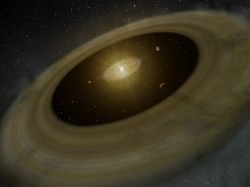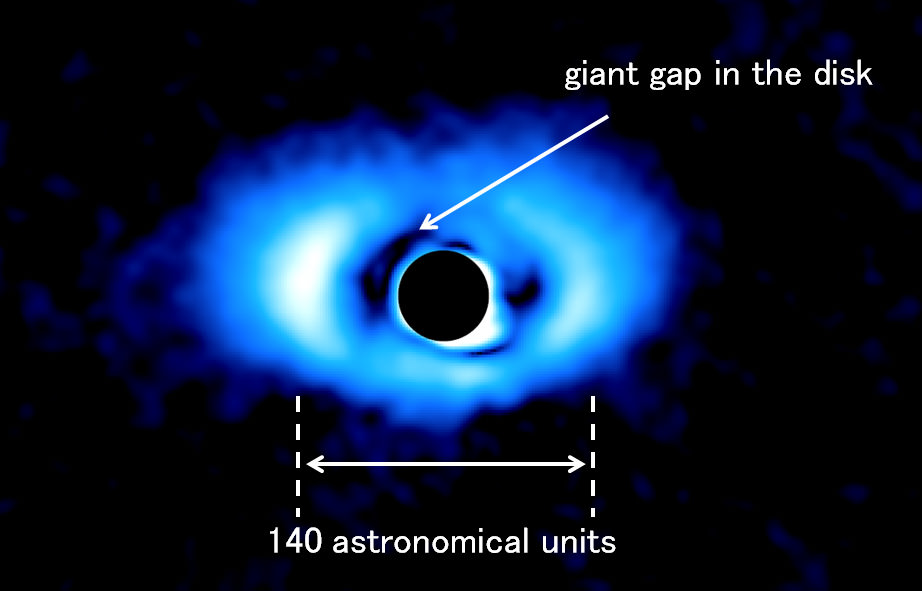HiCIAO near-infrared image of the protoplanetary disk around PDS 70. The circular mask hides the star itself, as well as a smaller internal disk structure. (Credit: NAOJ)
Over the past couple of decades astronomers have figured out several methods for finding planets around other stars in our galaxy. Some have revealed their presence by the slight “wobble” they impart to their host stars as they orbit, while others have been discovered as they pass in front of their stars from our perspective, briefly dimming the light we see.
Now, some astronomers think they may have identified the presence of multiple planets, based on a large gap found in the disk of gas and dust surrounding a Sun-like star 460 light-years from Earth.
Using the High Contrast Instrument for the Subaru Next Generation Adaptive Optics (HiCIAO) mounted on Japan’s 8.2-meter optical-infrared Subaru telescope atop Mauna Kea in Hawaii, an international team of astronomers targeted PDS 70, a young star (10 million years old) about the same mass as the Sun located 460 light-years away in the constellation Centaurus.
The near-infrared observations made by HiCIAO reveal a protoplanetary disk surrounding PDS 70. This disk is composed of gas and dust and extends billions of miles out from the star. Quite literally the stuff that planets are made of, it’s a disk much like this that our solar system likely started out as over 4.6 billion years ago.
“Thanks to the powerful combination of the Subaru Telescope and HiCIAO, we are able to probe the disks around Sun-like stars. PDS 70 shows how our solar system may have looked in its infancy. I want to continue this kind of research to understand the history of planetary formation.”
– Team Leader Jun Hashimoto (NAOJ)
Within PDS 70’s disk are several large gaps positioned at varying distances from the star itself, appearing as dark regions in the near-infrared data. These gaps — especially the largest, located about 70 AU from the star — are thought to be the result of newly-formed planets having cleared the surrounding space of dust and smaller material. It’s also believed that multiple planets may be present since, according to the team, “no single planet, regardless of how heavy or efficient it is in its formation, is sufficient to create such a giant gap.”
 In addition to the large disk structure and outer gap, PDS 70 also has a smaller disk located only 1 AU away. (This disk is obscured by the HiCIAO mask in the image above.)
In addition to the large disk structure and outer gap, PDS 70 also has a smaller disk located only 1 AU away. (This disk is obscured by the HiCIAO mask in the image above.)
Further observations will be needed to locate any actual exoplanets directly, since the light from the star and scattered light within the disk makes it difficult — if not impossible with current technology — to detect the incredibly faint light reflected by planets.
Still, it’s fascinating to come across what may very well be a solar system in its infancy, giving us a glimpse back in time to our own formation.
“Direct imaging of planets in the process of forming in protoplanetary disks would be ideal so that we can learn when, where, and how planets form,” said team leader Ruobing Dong of Princeton University.
Read more on the NAOJ website for the Subaru Observatory here.
The goal of the Strategic Exploration of Exoplanets and Disks with Subaru (SEEDS) Project is to study the disks around less massive stars like the Sun.
Inset image: Artist’s rendition of PDS 70 and its two protoplanetary disks (NAOJ)


Awesome! The possibility of watching litters of planets in (almost) all growth stages makes me very emotional, I didn’t think it was possible. This will mean a lot for understanding the process of planet system formation, I’m sure.
Speaking of litters, what would we call a group of adult planets? “A system” is too boring, “a clowder” (as for cats) too coarse. How about “a gazing”?
A velocity of planets?
A ‘mob’, like crows swarming a hawk.
I thought a group of crows was know as a “murder”?
I think you are right! I can’t remember what is called a mob, so maybe that is still free to use?
Correct me if I am wrong, but I think a number of nascent stellar systems have been observed with similar gaps in the nebular disk.
LC
Yes, but not with indications of a whole system cleared while retaining a memory of the protoplanetary disk. I know it sounds like fine print, but the implication is that we can observe the whole process to its end.
The closest I can think of is the images of Beta Pictoris b and its orbit.
But its age is perhaps less well constrained (8-20 Ma vs ~ 10 Ma) exactly as I remembered it, and above all I have never heard of claims of multiple planets needed to predict the system. The Wikipedia article proves that I have missed some developments:
“The observed planet by itself cannot explain the structure of the planetesimal belts at 30 AU and 52 AU from the star. These belts might be associated with smaller planets at 25 and 44 AU, with around 0.5 and 0.1 Jupiter masses respectively.[14] Such a system of planets, if it exists, would be close to a 1:3:7 orbital resonance. It may also be that the rings in the outer disc at 500–800 AU are indirectly caused by the influence of these planets.[14]”
Thank you for pushing me to update myself on the observational status of these intriguing objects!
It is interesting that evidence of planets in protoplanetary disks are far from the star. Most planets we observe with Doppler and transit methods are close in. The combined data might be used to statistically find what the orbital radii for extra-solar systems are.
LC
Thanks for the naming suggestions, I like them all!
Now we need to get the necessary IAU acceptance. =D
his article on Wikip might be of some use per discovering a good name for a group of planets in a system:
http://en.wikipedia.org/wiki/List_of_collective_nouns
Hai! Domo arigato Suburu!